After visiting Busan Biennale 2016
2016-10-24 l Hit 1546
On-site Visit 1
After visiting Busan Biennale 2016
(At the Busan Museum of Art and F1963 (KISWIRE Suyeong Factory) until November 30th)
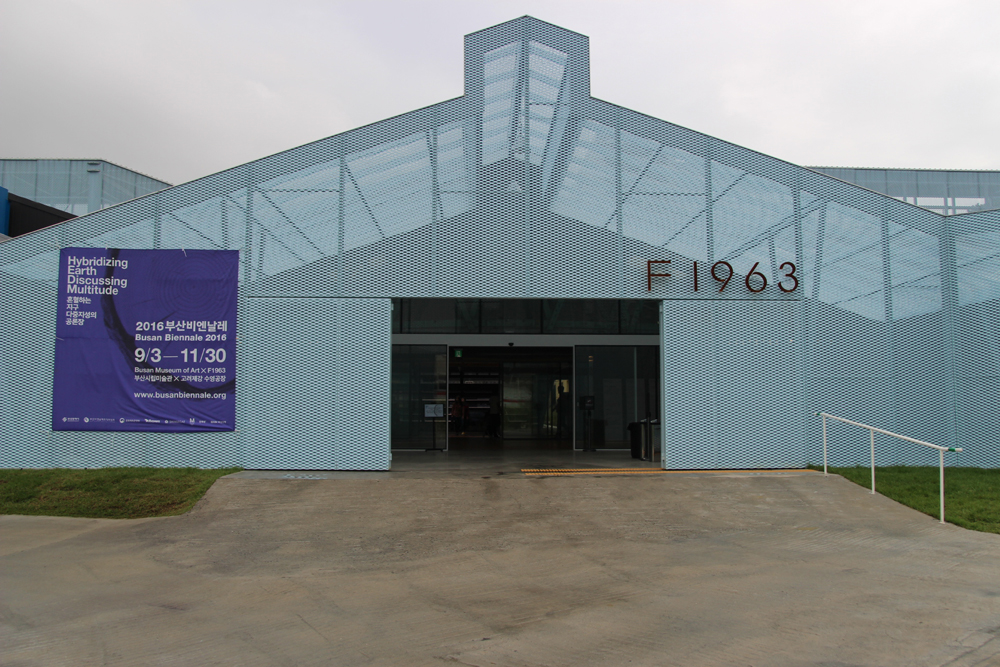 View of F1963, where ‘Project 2’ is being held. |
What is the definition of an art biennale? The dictionary defines it as an international art exhibition that is held once every two years. However, from my point of view, an art biennale has some kind of unapproachable qualities that go beyond the dictionary definition. ‘Work displayed in an art biennale is difficult,’ and ‘an art biennale pushes excessively grandiose discourse at its viewers.’ could be some of the prepositions that create a bias against art biennales.
I traveled to Busan, where ‘Busan Biennale 2016’ is being held, with this ‘question about the art biennale’ that nobody has yet answered clearly. I was glad that the biennale is also asking fundamental questions about itself among the many biennales that have flooded the art scene since the 1990s.
I went to the biennale site on October 8th, and it was a few days after the typhoon ‘Chaba’, one of the greatest of all time, wreaked havoc on the location. ‘Project 3 Channel B’, scheduled for that day, was canceled due to the typhoon. But other exhibitions were held as scheduled.
There are three exhibitions in the biennale: Project 1, Project 2, and Project 3, under the theme of ‘Hybridizing Earth, Discussing Multitude.’ Project 1 is being held at the Busan Museum of Art and consists of avant-garde work from Korea, China, and Japan. Project 2 is being held at F1963 (KISWIRE Suyeong Factory) with various artists participating, who are not bound by nationality, race, or religion. Project 3 is the program that connects Projects 1 and 2; it is made up of symposiums, performances, educational lectures, and other various events.
I first visited F1963, where Project 2 is being displayed. This building was originally a factory, built by a company called KISWIRE in 1963. Its name, F1963, originated as follows; F is the abbreviation for factory and 1963 refers to the year in which it was established. The building will be used as a complex cultural space even after the biennale.
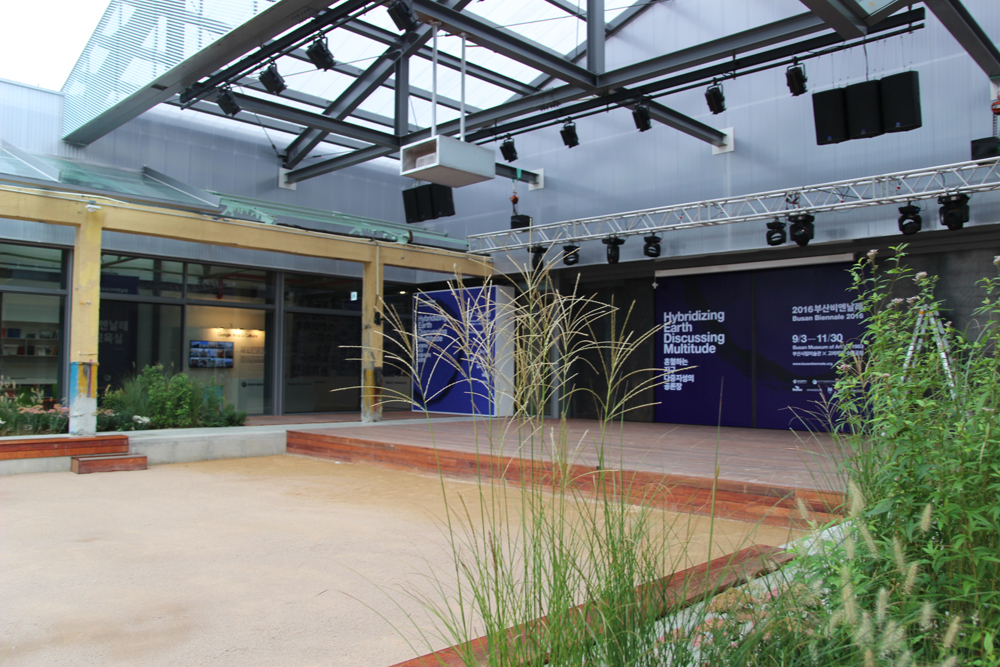 Performances and events are occasionally held in the courtyard of F1963, but those events for that day were canceled due to the weather. |
F1963 used its unique steel structures and components from the factory, which cannot be found in ordinary exhibition spaces, in order to create signage and flooring for open spaces. Therefore, its entire space seems like a giant sculpture.
The courtyard in F1963 divides the building into two large sections. The first section consists of a café, pub, and restaurant, where people can taste artists’ recipes, and an educational space for Project 3, which will open for the biennale. If you go inside, you can see the second section: an exhibition hall, where work is displayed.
‘Hybridizing Earth, Discussing Multitude.’
‘Hybridizing Earth’ describes the current time in which we transcend space and time via digital technology. Hybridizing is a term that goes further than ‘fusion,’ a concept that has been part of the art scene for a long time. ‘Hybridizing’ refers to ‘tertium quid (a third place)’ which contains everything, instead of mixing everything. We are also in ‘the era of the multitude’, in which anyone can easily express their opinions, feeling and discussing anything freely via the biennale.
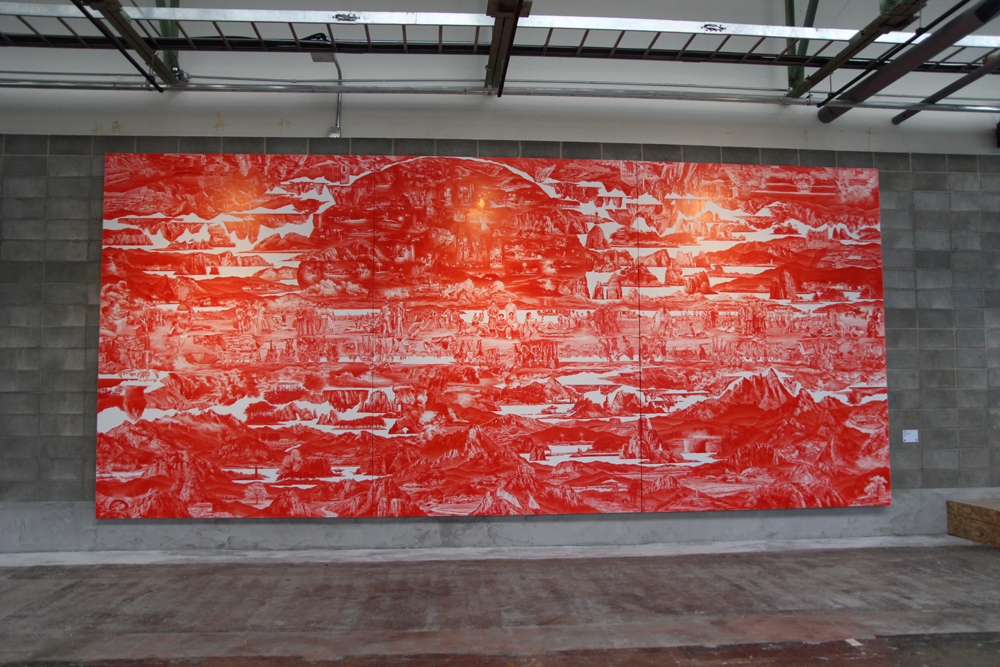 |
Upon entering the hall, ‘Between Red-187’, a huge red landscape piece by artist Seahyun LEE, attracted my attention right away. This intense work, aflame in red, is an extremely unrealistic landscape. At the same time, if I peered at it closely, I could spot many details, such as the foliage of nature, buildings, villages, and people.
Displayed beside that piece was artist JIN Yangping’s ‘Balloon Hit NO.1.’ This piece let viewers shoot the gun that was placed in before them to hit the balloons placed in front of the guns. After realizing that the balloons were placed where the head should be in the artist’s drawing, it was hard for viewers to pull the trigger. For better or worse, the gun was broken in that moment.
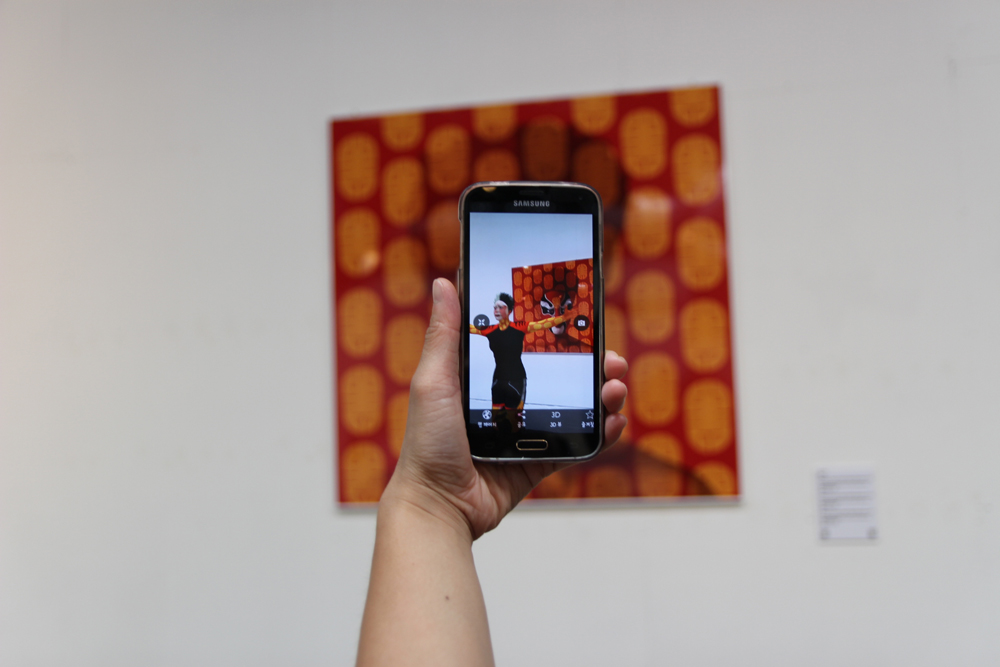 If viewers scan the work by artist ORLAN, they can experience augmented reality, in which an avatar of the artist performs Face Mask Changing (a traditional Chinese opera). |
The ‘Beijing Opera Self Hybridization’ by ORLAN was also interesting. The work looks like a photograph at first glance. However, if the viewer downloads an application called ‘Augment,’ and uses it to scan the work, it recognizes the application as a QR code. After this process, a tumbling avatar of the artist appears and viewers can take a picture with it.
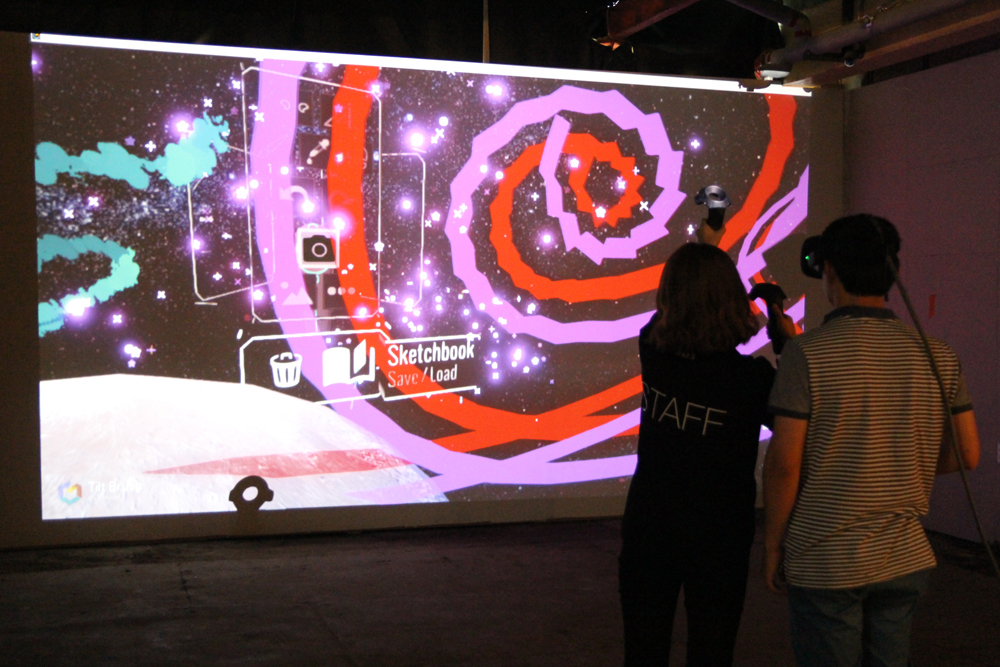 One of the viewers is experiencing ‘Hybridizing earth’ by artist Lee Nam LEE with the help of a staff member. If the viewer chooses a tilt brush and paints something in virtual reality, then they can print the image later. |
‘Hybridizing earth’ by artist Lee Nam LEE is one of the most popular pieces. The artist is well known for creating multimedia work by incorporating masterpieces of the East and West into his work. This time, he created work reflecting augmented reality. The work functions as follows; a viewer wears VR (virtual reality) goggles, paints on a screen with a tilt brush, and then prints out the painting. The prints were pretty nice, but it took some time to recharge the equipment, so I had to settle for watching other people’s experiences.
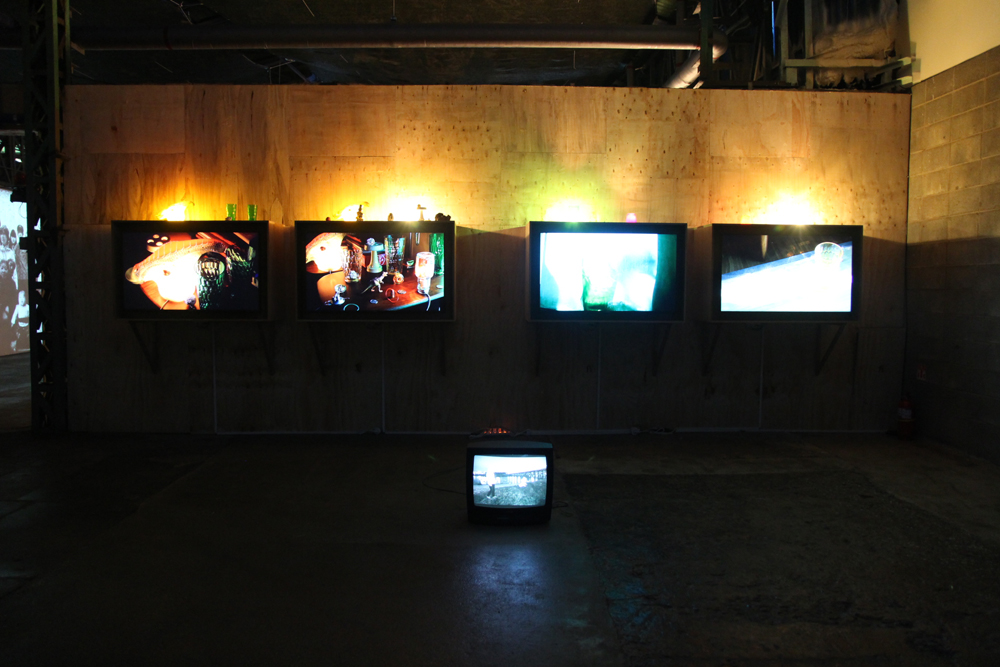 Multimedia work by artist Yangachi, in the corner of the exhibition hall. The combination of rough texture from the outer wall and the bizarre nature of the work creates a grotesque atmosphere. |
‘Old Spice, Lang Version’ by artist Yangachi upset people’s expectations and bewildered viewers. The work consists of four monitors, a Braun tube, and a few objects shown in a video. I felt that the work probably fit the keywords of the Biennale, ‘hybridizing’ and ‘multitude,’ the best as it reminded me of Frankenstein-like creatures.
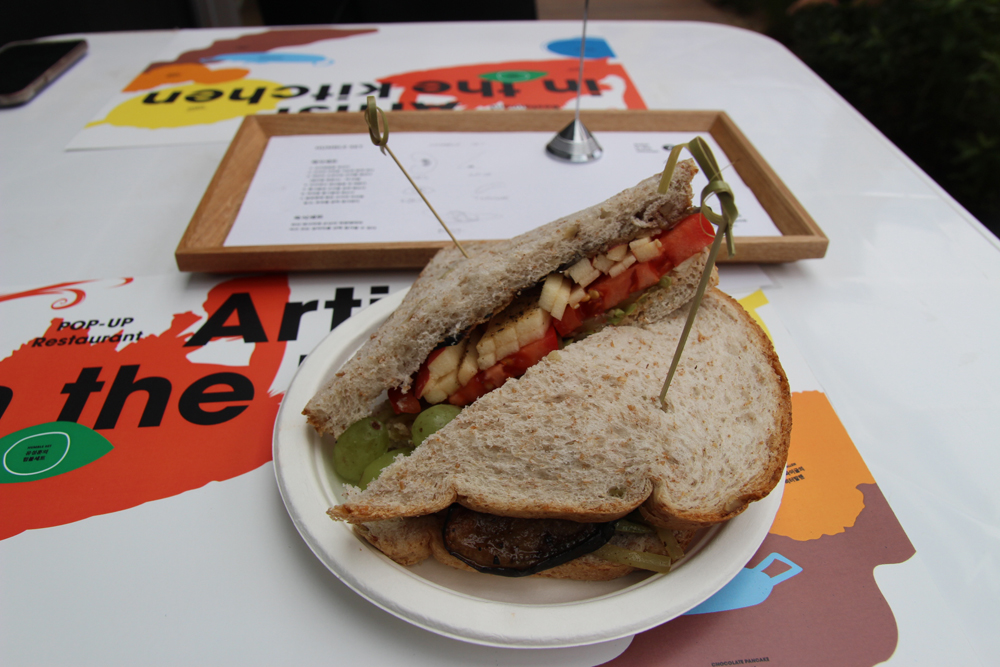 |
After looking around the exhibit hall, I decided to taste a recipe from one of the artists who provided recipes for the Biennale. I ordered the ‘Humble Set,’ made following the recipe created by artist YU Sunghoon. It was a vegetarian sandwich, and the artist described the dish as ‘a special recipe that was prepared for the staff members who worked hard to prepare the Biennale.’
I was surprised by the sandwich in two ways. One was from its appearance; it looked like a sandwich that you would see in a brunch café, and the other was the taste; it was much tastier than I expected.
Project 1, where Korean, Chinese, and Japanese avant-garde work are all in one place.
Leaving the fresh work from Project 2, I went to the Busan Museum of Art, where Project 1 was being held. It was a typical white cube exhibition in which nothing seemed special from a contemporary point of view. Though artist Bocsu JUNG, who is a member of KAP, exhibited work that was created in 1981, I found out that some work was by deceased artists.
Project 1 is an exhibition that tries to ruminate on experimental art in Korea, China, and Japan that has so far been under-appreciated. For the Korean art, the exhibition focuses on experimental art from the 1960s to the 1980s; including conceptual art, happening art, and multimedia art; that was overshadowed at the time by Dansaekhwa and Minjung art. For Chinese art, the exhibition deals with an era of resistance and conflict, from the Cultural Revolution to the Tiananmen Massacre, from 1976 to 1995. For Japanese art, it shows avant-garde pieces from the era of the atomic bombing of Hiroshima to the late 1980s.
The Chinese art exhibition is being held on the second floor, while the Korean and Japanese art exhibitions are shown on the third floor. In order to enter the exhibition hall for the Korean artwork, I had to step on the 'BADACHWA – Please, Tread on this painting' by artist Bocsu JUNG. Generally, viewers cannot even touch artwork, so I felt an odd kind of pleasure while stepping on the artwork.
The experimental work of artist LEE Seung-Taek also stood out. His work, which included a stone coiled with wire and a lit-up drawing floating down a river, was displayed in the exhibition, and was considered eccentric at the time of its creation. The exhibition also included some of the major work by artist PARK Hyun-ki, who is considered a first-generation video artist in Korea and a pioneer of multimedia art. It was a satisfactory experience for me to see his work in person instead of from his workbook, which included an image of him holding and leaning over a TV as if it were a fishbowl full of water, a TV placed inside a big stone tower, and some others.
In the Japanese artwork exhibit hall, ‘PAVILION,’ by the artist group Chim↑Pom, is definitely notable. Chim↑Pom consists of six members and it is the youngest artist group in the Project 1 exhibition. The piece is a huge sculpture, consisting of a large number of origami cranes, sent to Hiroshima from all over the world to appreciate the spirit of the Hiroshima victims. It was a unique experience for me to walk inside of the dark and winding sculpture. ‘26 Selling Bread People "PUNISHMENT,"’ by artist ORIMOTO Tatsumi, also caught my attention. The Christian martyrs who were executed by Toyotomi Hideyoshi in 1597 were the subjects of the work. The work consists of guillotines that were used in a performance, and a video of the performance playing in between the guillotines. The performance from the video stayed in my head for a long time.
The Chinese art was exhibited on the second floor. As I entered the exhibit hall, it had a thick Chinese atmosphere that reminded me that it displayed Chinese artwork. The attempt to continue tradition while experimenting with new possibilities is also very prevalent in China. Among the artwork, ‘Drama of Two Culture Formats Merge,’ by artist GU Wenda, was impressive. It seemed like the artist is giving viewers a riddle to solve by using the words ‘Two Culture’ in the title, which could refer to the East and West in art or the political issues in China. The ‘Tattoo’ by artist QIU Zhijie was intense even though it was made in the 1980s; it shows the artist standing next to a white wall with the Chinese word ‘不’, which means no, and a circle-backslash symbol painted in red partially on his body and partially on the wall.
I must confess that I could not focus on the work well enough in Project 1, since I had been looking at work for a long time at F1963, from work made with the latest IT to contemporary work. Therefore, the work from Project 1 was not as impressive. However, considering that avant-garde work from the three northeast Asian countries has been underrated, and there are viewers who think of contemporary art as difficult, it was worth emphasizing the avant-garde work through the biennale. It would only have been better if I had seen the Project 1 exhibition first.
Ironically, it seems that I was able to get a clue to answering the question about art biennales, which nobody has answered yet, while seeing this inconspicuous Project 1 exhibition. I thought that the shocking, experimental, and difficult work displayed in biennales could be the gestures that try to show the contemporary era that we live in. As we cannot define the world that we live in with a word, it could also be true that biennales cannot be clearly defined by a single word.
2016. 10. 28 ⓒKorean Artist Project
Text and images may not be reproduced, reprinted, or redistributed without express consent.








